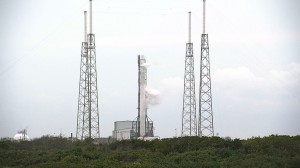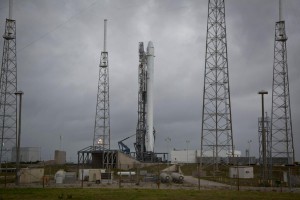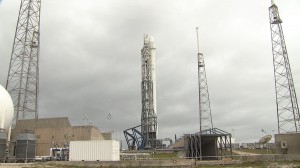 At T-30 minutes, we remain on pace for liftoff on-time at 3:25 p.m. EDT. One of the experiments Dragon is carrying is called OPALS. It will demonstrate a data transmission using lasers which can carry far more data than radio frequencies. The increase is important because the research projects on the station produce a wide range of useful data for analysis. Find out more about OPALS here.
At T-30 minutes, we remain on pace for liftoff on-time at 3:25 p.m. EDT. One of the experiments Dragon is carrying is called OPALS. It will demonstrate a data transmission using lasers which can carry far more data than radio frequencies. The increase is important because the research projects on the station produce a wide range of useful data for analysis. Find out more about OPALS here.
Dragon’s Cargo
The Dragon spacecraft that is being launched into orbit today carries about 5,000 pounds of equipment including science experiments, a spacewalking suit, called an EMU for extravehicular maneuvering unit, plus other spacesuit hardware. There is also a set of robotic legs that will be connected to Robonaut2. The R2 torso is already on the International Space Station where it has been performing numerous tests and simple tasks. You can read more about Robonaut2 and its legs here and here.
Meet the Octaweb

This is the first NASA mission by SpaceX that includes an upgraded version of the Falcon 9. Outwardly, the biggest change is an arrangement of eight engines in a circle around the center engine. Previously, the nine engines were built in three rows of three. SpaceX says the octaweb reduces the length and weight of the Falcon 9 thrust structure and streamlines manufacturing of the first stage. While this is the first NASA mission with an octaweb first stage, the engine pattern flew successfully during several previous SpaceX missions launching commercial payloads.
One Hour Until Launch
 At T-60 minutes, all remains on track for the SpaceX-3 mission to lift off on time at 3:25 p.m. EDT. The spacecraft carries no people, but is loaded with about 5,000 pounds of supplies, experiments and equipment for the International Space Station and its crew of astronauts. Six people live on the space station now conducting research and learning about long-duration spaceflight. Launch Weather Officer Mike McAleenan just improved the forecast to a 60 percent chance of acceptable conditions at launch time. Again, all conditions are “go” now and there are no technical concerns.
At T-60 minutes, all remains on track for the SpaceX-3 mission to lift off on time at 3:25 p.m. EDT. The spacecraft carries no people, but is loaded with about 5,000 pounds of supplies, experiments and equipment for the International Space Station and its crew of astronauts. Six people live on the space station now conducting research and learning about long-duration spaceflight. Launch Weather Officer Mike McAleenan just improved the forecast to a 60 percent chance of acceptable conditions at launch time. Again, all conditions are “go” now and there are no technical concerns.
Falcon 9 Rocket Fueled for Launch
The Falcon 9 rocket has been loaded with the kerosene fuel and liquid oxygen that will power the nine first stage engines and one second stage engine during launch and the flight into orbit. The first stage engines will generate about 900,000 pounds of thrust at liftoff. The launch window is instantaneous, meaning the liftoff has to occur at precisely 3:25:22 to reach the International Space Station.
Good Afternoon and Welcome to the NASA Launch Blog!

We’re an hour and 10 minutes from the scheduled launch of the third operational SpaceX cargo resupply mission to the International Space Station. The skies over our Florida launch site have been clearing in the last hour or so and the weather is not violating any of the launch criteria right now. Liftoff remains on target for 3:25 p.m. EDT from Launch Complex 40 at Cape Canaveral Air Force Station. The weather forecast continues to call for a 40 percent chance of acceptable conditions at launch time. You can also watch NASA TV’s streaming launch coverage here.
Weather Improving

The Launch Weather Officer reports that conditions around Cape Canaveral improving this afternoon. The weather remains unstable, but all constraints have been cleared and the weather is expected to remain “go” through launch time. Officially, the forecast remains at a 40 percent chance of acceptable conditions for the 3:25 p.m. EDT launch time. NASA TV coverage will begin at 2:15 p.m. You can watch at nasa.gov/ntv
Launch Day Dawns in Florida
 Good morning from a cloudy Florida where SpaceX is preparing to launch its third operational mission to the International Space Station. The Falcon 9 rocket and Dragon spacecraft loaded with cargo have been rolled to the launch pad at Launch Complex 40 at Cape Canaveral Air Force Station and raised to its vertical launch position. Today’s launch time is 3:25 p.m. EDT with an instantaneous launch window to allow a link up with the International Space Station. The weather forecast still offers a 40 percent chance of acceptable conditions at launch time and meteorologists will spend the day surveying the skies for signs of thick clouds or other launch rule violations. NASA’s continuous coverage will begin on the Launch Blog and NASA TV at 2:15 p.m. In the meantime, we will report breaking news here as events warrant.
Good morning from a cloudy Florida where SpaceX is preparing to launch its third operational mission to the International Space Station. The Falcon 9 rocket and Dragon spacecraft loaded with cargo have been rolled to the launch pad at Launch Complex 40 at Cape Canaveral Air Force Station and raised to its vertical launch position. Today’s launch time is 3:25 p.m. EDT with an instantaneous launch window to allow a link up with the International Space Station. The weather forecast still offers a 40 percent chance of acceptable conditions at launch time and meteorologists will spend the day surveying the skies for signs of thick clouds or other launch rule violations. NASA’s continuous coverage will begin on the Launch Blog and NASA TV at 2:15 p.m. In the meantime, we will report breaking news here as events warrant.
SpaceX Details Helium Leak
SpaceX released some of the details about the helium leak in the Falcon 9 rocket that scrubbed Monday’s launch attempt of the SpaceX cargo resupply mission to the International Space Station. Here is what the company said: “During Monday’s launch attempt, preflight checks detected that a helium valve in the stage separation pneumatic system was not holding the right pressure. This meant that the stage separation pistons would be reliant on a backup check valve. No issue was detected with the backup valve and a flight would likely have been successful, but SpaceX policy is not to launch with any known anomalies. We have brought the vehicle back to horizontal and are replacing the faulty valve, as well as inspecting the whole system for anything that may have contributed to the valve not working as designed.”
SpaceX-3 is slated for liftoff Friday at 3:25 p.m. EDT. Saturday was chosen as the backup day for launch with a launch time of 3:02 p.m. EDT.
SpaceX Selects Friday for Launch, Saturday Backup
The International Space Station Program and SpaceX have selected Friday, April 18 for the next launch attempt for the Falcon 9 rocket to send the Dragon cargo craft on the company’s third commercial resupply mission to the space station. Launch is scheduled for 3:25 p.m. EDT. The NASA Launch Blog and NASA TV coverage will begin at 2:15 p.m.
A launch on Friday results in a rendezvous with the space station on Sunday, April 20 and a grapple at 7:14 a.m. NASA TV coverage will begin at 5:45 a.m. with berthing coverage beginning at 9:30 a.m.
SpaceX has settled on a backup launch date of Saturday, April 19 for the best pair of launch dates for the science payloads being delivered to the station. If needed, a Saturday launch would occur at 3:02 p.m. This would be a three-day transit to the station instead of two days with grapple on Tuesday, April 22.
